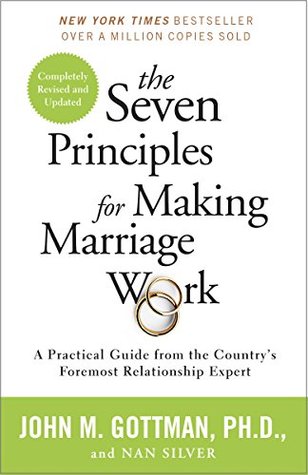More on this book
Community
Kindle Notes & Highlights
The notion that you can save your relationship just by learning to communicate more sensitively is probably the most widely held misconception about happy marriages—but
The point is that neuroses don’t have to ruin a marriage. If you can accommodate each other’s “crazy” side and handle it with caring, affection, and respect, your marriage can thrive.
But needing to keep a running tally of who has done what for whom is really a sign of trouble in a marriage. Among happy spouses, one doesn’t load the dishwasher just as payback because the other cooked but out of overall positive feelings about the partner and relationship.
happy marriages are based on a deep friendship. By this I mean a mutual respect for and enjoyment of each other’s company. These couples tend to know each other intimately—they are well versed in each other’s likes, dislikes, personality quirks, hopes, and dreams. They have an abiding regard for each other and express this fondness not just in the big ways but through small gestures day in and day out.
This means that their positive thoughts about each other and their marriage are so pervasive that they tend to supersede their negative feelings.
Once your marriage gets “set” at a high degree of positivity, it will take far more negativity to harm your relationship than if your “set point” were lower. And if your relationship becomes overwhelmingly negative, it will be more difficult to repair.
When a couple have a strong friendship, they naturally become experts at sending each other repair attempts and at correctly reading those sent their way.
The success or failure of a couple’s repair attempts is one of the primary factors in whether their marriage is likely to flourish or flounder.
The research shows that if your discussion begins with a harsh start-up, it will inevitably end on a negative note, even if there are a lot of attempts to “make nice” in between. Statistics tell the story: 96 percent of the time you can predict the outcome of a conversation based on the first three minutes of the fifteen-minute interaction!
Usually these four horsemen clip-clop into the heart of a marriage in the following order: Criticism, Contempt, Defensiveness, and Stonewalling.
there’s a world of difference between complaint and criticism. A complaint focuses on a specific behavior or event. “I’m really angry that you didn’t sweep the kitchen last night. We agreed that we’d take turns. Could you please do it now?” is a complaint. Like many complaints, it has three parts: (1) Here’s how I feel (“I’m really angry”); (2) About a very specific situation (“you didn’t sweep last night”); (3) And here’s what I need/want/prefer (“Could you do it now?”). In contrast, a criticism is global and expresses negative feelings or opinions about the other’s character or personality:
...more
Two very common forms of criticism are statements that contain “you always” or “you never.”
Although it’s understandable that Cynthia would defend herself, research shows that this approach rarely has the desired effect. The attacking spouse does not back down or apologize. This is because defensiveness is really a way of blaming your partner. You’re saying, in effect, “The problem isn’t me, it’s you.”
Stonewalling usually arrives later in the course of a marriage than the other three horsemen.
feeling psychologically and physically overwhelmed, a sensation we call flooding.
Recurring episodes of flooding lead to divorce for two reasons. First, they signal that at least one partner feels severe emotional distress when dealing with the other. Second, the physical sensations of feeling flooded—the increased heart rate, sweating, and so on—make it virtually impossible to have a productive, problem-solving discussion.
the male cardiovascular system remains more reactive than that of the female and slower to recover from stress.
men have a greater tendency to have negative thoughts that maintain their distress, while women are more likely to think soothing thoughts that help them calm down and be conciliatory. Men, generally, either think about how righteous and indignant they feel (“I’m going to get even,” “I don’t have to take this”), which tends to lead to contempt or belligerence, or think about themselves as an innocent victim of their wife’s wrath or complaint (“Why is she always blaming me?”), which leads to defensiveness.
Because of these dissimilarities, most marriages (including healthy, happy ones) follow a comparable pattern of conflict in which the wife, who is constitutionally better able to handle the stress, brings up sensitive issues. The husband, who is not as able to cope with it, will attempt to avoid getting into the subject.
Frequently feeling flooded leads almost inevitably to emotional distancing, which in turn leads to feeling lonely.
Especially when you’re feeling flooded, you’re not able to hear a verbal white flag.
Whether a repair succeeds or fails has very little to do with how eloquent it is and everything to do with the state of the marriage.
Whatever the route, there are four final stages that signal the death knell of a relationship. 1. The couple see their marital problems as severe. 2. Talking things over seems useless. Partners try to solve problems on their own. 3. The couple lead parallel lives. 4. Loneliness sets in.
You can see the seeds of trouble in (1) what partners actually say to each other (the prevalence of harsh start-up, the four horsemen, and the unwillingness to accept influence), (2) the failure of their repair attempts, (3) physiological reactions (flooding), or (4) pervasive negative thoughts about their marriage.
the key to reviving or divorce-proofing a relationship is not simply how you handle your disagreements but how you engage with each other when you’re not fighting.


